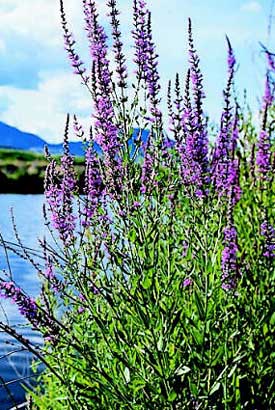Gardeners in BC enjoy some of the best growing conditions in Canada, allowing for a spectacular display of attractive exotic and native trees, shrubs, and flowers. As a result, horticulture is a vibrant and growing industry, but also a key pathway for invasive or 'unwanted' plants.
Invasive plants jump the garden fence and become a problem along roadways, rangelands, disturbed open areas, public parks, and residential areas. They impact the environment, economy, and in some cases, human health and safety. Introduced without their natural predators, invasive plants grow rapidly, spread quickly, and can form dense patches that displace native species and disrupt natural ecosystems.
By making informed choices, gardeners can make a difference in the prevention of invasive plants and help safeguard BC's environment and economy for future generations.
Follow these tips to grow a non-invasive garden:
- Select non-invasive exotic and/or regional native plants. Native plants are naturally adapted to the local environment. Avoid picking plants from roadsides, as many wildflowers are aggressive invasive plants (eg. Oxeye Daisy).
- Learn about invasive plants in your area and select the right plant for the right place. Be suspicious of exotic plants promoted as 'fast spreaders' or 'vigorous self-seeders', as these are often invasive plants.
- Control invasive plants on your property using site- and species-appropriate methods. For example: hand pulling, digging, cutting, and mowing.
- Deadhead (clip off) flowers, seedpods, and berries of known invasive plants to prevent reproduction through seeds and to reduce seed spread by birds, wildlife, pets, and people.
- Dispose of invasive plant parts and seeds responsibly (i.e. bag and landfill or incinerate). Most invasive plants should not be composted.
- Replace invasive plants with non-invasive alternatives. Refer to the Grow Me Instead booklet to find suggested alternatives for 13 of BC's most unwanted invasive plants in horticulture.
Establishing a non-invasive garden is a great way to help prevent the spread of invasive plants. Other ways you can help are to report invasive plants (1-888-WEEDSBC), participate in 'Communities Pulling Together' weed pull events, and support local botanical gardens, nurseries, and gardening clubs that promote, display or sell non-invasive plants.
The Invasive Plant Council of BC is a grassroots, non-profit society working collaboratively to build cooperation and coordination of invasive plant management in BC. IPCBC workshops, activities, and events educate the public and professionals about invasive plants, their potential risks and responsible practices. For more information or to become a member (at no cost), visit www.invasiveplantcouncilbc.ca, email info@invasiveplantcouncilbc.ca or call 1-888-WEEDSBC.
Grow Me Instead booklet
To raise awareness and improve industry practices, the IPCBC, the BC Landscape and Nursery Association, provincial government, gardeners, regional committees, landscapers, and retailers collaborated in the development of a Grow Me Instead booklet. This 30 page booklet identifies horticulture's most "unwanted" invasive plants in BC while providing a varity of native and non-invasive ornamental alternatives. By undertaking responsible gardening practices outlined in the booklet, gardeners can help decrease the impact of invasive plants while still achieving vibrant and dynamic gardens.
A Snapshot Brochure of the Grow Me Instead booklet was also developed. This smaller brochure captures a thumbnail image of the 13 most unwanted plants described in the booklet, matched wtih recommended alternatives.
The Grow Me Instead booklet can be found at many nursery and garden outlets across the province. Alternatively, the booklet and Snapshot brochure can be ordered from the IPCBC office (250-392-1400) for a small fee, or downloaded from the Council website http://www.invasiveplantcouncilbc.ca
Author: Julianne Leekie, Communications Coordinator, Invasive Plant Council of BC





